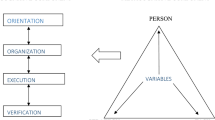Abstract
One of the well-known approaches to creativity differentiates between creative person, process, product, and press. In the study presented in this paper we focus on creative process and product associated with Problem Posing through Investigation (PPI) by experts in mathematical problem solving. We link the creative process to creativity of PPI strategies and the creative product to PPI outcomes (i.e., strategy creativity and outcome creativity). Furthermore, we draw a connection between the openness of tasks and their power for the evaluation of strategy creativity and outcome creativity, demonstrate the aptness of PPI tasks for the evaluation of both types of creativity, and examine the connections between them. The model for the evaluation of creativity that we used in this study, was initially designed and validated using analysis of problem-solving strategies when solving multiple solution tasks. We previously extended the model to evaluation of PPI outcomes, and we here demonstrate its implementation to evaluation of creativity of PPI strategies. To examine connections between creativity of PPI strategies and creativity of PPI outcomes, we focused on PPI by eight experts in mathematical problem solving who were members or candidates of the Israeli IMO team. We present empirical evidence for the distinctions between strategy creativity and outcome creativity, and for the connections between them. We analyzed strategy creativity as a unique characteristic of problem-solving experts. We found that higher strategy creativity does not necessarily lead to higher outcome creativity, and that a high level of strategy originality correlates with outcome flexibility. We conclude that creative product and creative process are two distinct characteristics of cognitive processing linked to creativity-directed problem solving.



Similar content being viewed by others
References
Amado, N., Carreira, S., & Jones, K. (Eds.). (2018). Broadening the scope of research on mathematical problem solving: A focus on technology, creativity and affect. Springer.
Beghetto, R. A., & Kaufman, J. C. (2015). Promise and pitfalls in differentiating amongst the C’s of creativity. Creativity Research Journal, 27, 240–241.
Besemer, S. P., & O’Quin, K. (1987). Creative product analysis: Testing a model by developing judging instruments. In S. G. Isaksen (Ed.), Frontiers of creativity research (pp. 341–357). Bearly Limited.
Bokhove, C., & Jones, K. (2018). Stimulating mathematical creativity through constraints in problem-solving. In N. Amado, S. Carreira, & K. Jones (Eds.), Broadening the scope of research on mathematical problem solving (pp. 301–319). Springer.
Csikszentmihalyi, M. (1988). Society, culture, and person: A systems view of creativity. In R. J. Sternberg (Ed.), The nature of creativity (pp. 325–339). Cambridge University Press.
Csikszentmihalyi, M. (1996). Creativity: Flow and the psychology of discovery and invention. Harper Perennial.
Duncker, K. (1945). On problem-solving (L. S. Lees, Trans.). Psychological Monographs, 58(5), 1–113.
Elgrably, H., & Leikin, R. (2021). Creativity as a function of problem-solving expertise: Posing new problems through investigations. ZDM—Mathematics Education 53(4), 891–904.
Ervynck, G. (1991). Mathematical creativity. In D. Tall (Ed.), Advanced mathematical thinking (pp. 42–53). Kluwer.
Gontijo, C. H. (2018). Mathematics education and creativity: A point of view from the systems perspective on creativity. In N. Amado, S. Carreira, & K. Jones (Eds.), Broadening the scope of research on mathematical problem solving (pp. 375–386). Springer.
Griffin, P. E., McGaw, B., & Care, E. (2012). Assessment and teaching of 21st century skills. Springer.
Guilford, J. P. (1956). The structure of intellect. Psychological Bulletin, 53, 267–293.
Hadamard, J. (1945). The psychology of invention in the mathematical field. Princeton University Press.
Kaufman, J. C., & Beghetto, R. A. (2009). Beyond big and little: The four c model of creativity. Review of General Psychology, 13(1), 1.
Kleiman, P. (2005). Beyond the tingle factor: Creativity and assessment in higher education. Paper presented at the ESRC Creativity Seminar, University of Strathclyde. Accessed 5 Jan 2021. http://citeseerx.ist.psu.edu/viewdoc/download?doi=10.1.1.576.6056&rep=rep1&type=pdf.
Klein, S., & Leikin, R. (2020). Opening mathematical problems for posing open mathematical tasks: What do teachers do and feel? Educational Studies in Mathematics, 105(3), 349–365.
Koichu, B., & Andžaāns, A. (2009). Mathematical creativity and giftedness in out-of-school activities. In R. Leikin, A. Berman, & B. Koichu (Eds.), Creativity in mathematics and education of gifted students (pp. 285–308). Sense Publishers.
Leikin, R., & Elgrably, H. (2015). Creativity and expertise—The chicken or the egg? Discovering properties of geometry figures in DGE. In The Proceedings of the Eighth Conference of the European Society for Research in Mathematics Education, CERME-9 (pp. 1024–1031).
Leikin, R. (2009). Exploring mathematical creativity using multiple solution tasks. In R. Leikin, A. Berman, & B. Koichu (Eds.), Creativity in mathematics and the education of gifted students (pp. 129–145). Sense Publishers.
Leikin, R. (2014). Challenging mathematics with multiple solution tasks and mathematical investigations in geometry. In Y. Li, E. A. Silver, & S. Li (Eds.), Transforming mathematics instruction: Multiple approaches and practices (pp. 59–80). Springer.
Leikin, R. (2018). Openness and constraints associated with creativity-directed activities in mathematics for all students. In N. Amado, S. Carreira, & K. Jones (Eds.), Broadening the scope of research on mathematical problem solving: A focus on technology, creativity and affect (pp. 387–397). Springer.
Leikin, R., & Elgrably, H. (2020). Problem posing through investigations for the development and evaluation of proof skills and creativity skills of prospective high school mathematics teachers. International Journal of Educational ResEarch. https://doi.org/10.1016/j.ijer.2019.04.002
Leikin, R., & Grossman, D. (2013). Teachers modify geometry problems: From proof to investigation. Educational Studies in Mathematics, 82(3), 515–531.
Leikin, R., Leikin, M., Paz-Baruch, N., Waisman, I., & Lev, M. (2017). On the four types of characteristics of super mathematically gifted students. High Ability Studies, 28(1), 107–125.
Leikin, R., & Sriraman, B. (Eds.). (2016). Creativity and giftedness: Interdisciplinary perspectives from mathematics and beyond (pp. 1–3). Springer.
Levav-Waynberg, A., & Leikin, R. (2012). The role of multiple solution tasks in developing knowledge and creativity in geometry. Journal of Mathematical Behavior, 31, 73–90.
Liljedahl, P., & Sriraman, B. (2006). Musings on mathematical creativity. For the Learning of Mathematics, 26, 20–23.
Lytton, H. (1971). Creativity and education. Routledge.
Nohda, N. (1995). Teaching and evaluating using “open-ended problem” in classroom. ZDM—the International Journal on Mathematics Education, 27(2), 57–61.
OECD. (2019). Framework for the assessment of creative thinking in PISA 2021. Accessed Nov 2020. https://www.oecd.org/pisa/publications/PISA-2021-creative-thinking-framework.pdf.
Pehkonen, E. (1995). Introduction: Use of open-ended problems. ZDM—the International Journal on Mathematics Education, 27(2), 55–57.
Pellegrino, J.W., & Hilton, M.L. (2012). Educating for life and work: Developing transferable knowledge and skills in the 21st century. NRC, the National Academies Press. https://doi.org/10.17226/13398.
Plucker, J. A., Beghetto, R. A., & Dow, G. T. (2004). Why isn’t creativity more important to educational psychologists? Potentials, pitfalls, and future directions in creativity research. Educational Psychologist, 39(2), 83–96.
Sheffield, L. J. (2009). Developing mathematical creativity—Questions may be the answer. In R. Leikin, A. Berman, & B. Koichu (Eds.), Creativity in mathematics and the education of gifted students (pp. 87–100). Sense Publishers.
Silver, E. A. (1995). The nature and use of open problems in mathematics education: Mathematical and pedagogical perspectives. ZDM—the International Journal on Mathematics Education, 27, 67–72.
Silver, E. A. (1997). Fostering creativity through instruction rich in mathematical problem solving and problem posing. ZDM—the International Journal on Mathematics Education, 3, 75–80.
Silver, E. A., Mamona-Downs, J., Leung, S. S., & Kenney, P. A. (1996). Posing mathematical problems: an exploratory study. Journal for Research in Mathematics Education, 27, 293–309.
Singer, F. M., & Voica, C. (2015). Is problem posing a tool for identifying and developing mathematical creativity. In N. F. Ellerton & J. Cai (Eds.), Singer FM (pp. 141–174). Mathematical problem posing. from research to effective practice. Springer.
Sriraman, B. (2005). Are giftedness & creativity synonyms in mathematics? An analysis of constructs within the professional and school realms. The Journal of Secondary Gifted Education, 17, 20–36.
Star, J. R., & Newton, K. J. (2009). The nature and development of experts’ strategy flexibility for solving equations. ZDM—the International Journal on Mathematics Education, 41(5), 557–567.
Sternberg, R. J., & Lubart, T. I. (2000). The concept of creativity: Prospects and paradigms. In R. J. Sternberg (Ed.), Handbook of creativity (pp. 93–115). Cambridge University Press.
Stoyanova, E., & Ellerton, N. F. (1996). A framework for research into students’ problem posing in school mathematics. In P. C. Clarkson (Ed.), Technology in mathematics education (pp. 518–525). MERGA.
Tabach, M., & Levenson, E. (2018). Solving a task with infinitely many solutions: Convergent and divergent thinking in mathematical creativity. In N. Amado, S. Carreira, & K. Jones (Eds.), Broadening the scope of research on mathematical problem solving (pp. 219–242). Springer.
Torrance, E. P. (1974). Torrance tests of creative thinking. Scholastic Testing Service.
Usiskin, Z. (2000). The development into the mathematically talented. Journal of Secondary Gifted Education, 11, 152–162.
Vygotsky, L.S. (1930/1982). Imagination and its development in childhood. In V. V. Davydov (Ed.), Vol. 2: General problems of psychology. The collected works of L. S. Vygotsky (pp. 438–454). Pedagogika (in Russian).
Vygotsky, L. S. (1930/1984). Imagination and creativity of the adolescent. In D. B. Elkonin (Ed.), Vol. 4: Child psychology. The collected works of L. S. Vygotsky (pp. 199–219). Pedagogika (in Russian).
Wallas, G. (1926). The art of thought. Harcourt.
Wechsler, S. M., et al. (2018). Creative and critical thinking: Independent or overlapping components? Thinking Skills and Creativity, 27, 114–122.
Author information
Authors and Affiliations
Corresponding author
Additional information
Publisher's Note
Springer Nature remains neutral with regard to jurisdictional claims in published maps and institutional affiliations.
Rights and permissions
About this article
Cite this article
Leikin, R., Elgrably, H. Strategy creativity and outcome creativity when solving open tasks: focusing on problem posing through investigations. ZDM Mathematics Education 54, 35–49 (2022). https://doi.org/10.1007/s11858-021-01319-1
Accepted:
Published:
Issue Date:
DOI: https://doi.org/10.1007/s11858-021-01319-1




